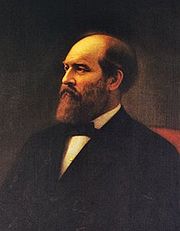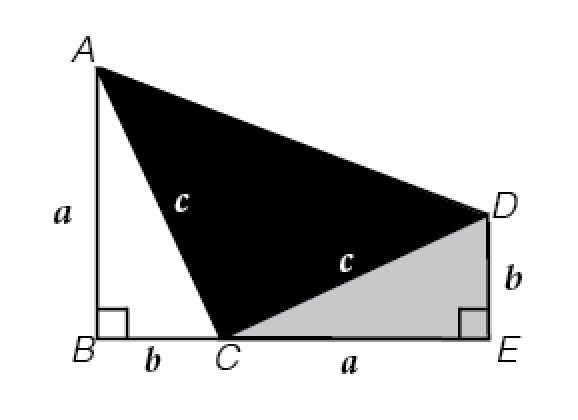
James Abram Garfield was born on November 19, 1831 in Moreland Hills, in a log cabin in northeastern Ohio. Before James’ second birthday, his father died, leaving him and his 4 siblings to be raised by their mother, Eliza. Described as a woman of strong will, she formed a deep bond with James who acquired a strong work ethic as he observed her unrelenting efforts to provide for the family.
Daily chores in the family’s struggle for survival meant that his early education was acquired through home schooling. Highly intelligent children are often perceived by their peers as “different” and consequently suffer ostracism and isolation. This was the case for James whose poverty and fatherless status exascerbated his isolation. He found solice in his voracious appetite for reading–a major factor in developing his wide range of interests. In 1847 at the age of 16, James took a job guiding the mules that pulled canal boats along the Ohio River to Lake Erie. This job lasted only about 6 weeks and by 1848, he was enrolled at the Geauga Seminary School where he discovered his passion for learning. Described as an outstanding student, he showed a particular flair for languages and a strong interest in public speaking, once announcing, “I love agitation and investigation and glory in defending unpopular truth against popular error.” He graduated from Geauga Seminary School in 1850.
In the year after graduation, Garfield supported himself working as a tutor and teacher, traveling to wherever such jobs were available. Then in 1851, he enrolled in a school run by a religious order that later became known as Hiram College. He became immersed in classical studies, involving Latin and Greek, and demonstrated such capability, that he was given teaching duties while still enrolled as a student. In 1854, Garfield enrolled in Williams College in Massachusetts and graduated Phi Beta Kappa two years later, standing second in the class and delivering a speech at the convocation. In 1857, he returned to Hiram College as a professor of classical studies and became the school Principal. As unrest between the northern and southern states began to foment, Garfield became increasingly interested in political issues such as the abolition movement. He left Hiram College, earned his law degree, and by 1859 was was elected to Ohio State Senate as a Republican representative where he served for 2 years.
When the Civil War erupted in 1861, James Garfield was appointed major general in the Union army. He was actively involved in several battles, and his strategic analysis enabled his army to prevail in the battle of Middle Creek–a victory that earned him a promotion to brigadier general. These significant military achievements, were a factor in his election to Congress the following year.
The analytical approach that Garfield brought to his military strategies pervaded his work in politics and even in his private life. In 1876, he published his unique proof of the Pythagorean theorem, shown below.

Garfield started with the right triangle ABC, made a copy (triangle CDE) and then joined vertices A and D to make trapezoid ABED. Then the area of ABED is just (a +b)2÷ 2. The area of ABED can also be written as the sum of the areas of the three triangles, i.e., ½ab, ½ab, and ½c2. Equating the two expressions for the area of ABED yields a2 + b2 = c2.
The triangle ACD is a right triangle because BCA and DCE are complementary, and that is why the area of triangle ACD is ½c2.”
By 1880, the Civil war was in the rear-view mirror of an American electorate that was becoming more concerned with economic issues such as tariffs, and this played a vital role in the election of Garfield as the 20th President of the United States. From the beginning of his presidency, James Garfield championed civil rights and strongly advocated governmental support for the education of African Americans. He also eradicated corruption in the Post Office Department and fought hard for the strengthening of the military to protect the US against foreign aggressors.
On July 2, 1881, a disgruntled wannabe for an appointment as consul in Paris, named Charles J. Giteau appeared out of the shadows and shot James Garfield twice–one bullet hitting his arm and the other his back. The injuries were not fatal, but the inability of doctors to locate the bullet resulted in a long-term infection that eventually led to Garfield’s death on November 19, 1881. Giteau was hanged on June 30, 1882.
Tragically, James Garfield’s life was snuffed out after he had served only the first 6 months of his presidency and we can only imagine what he might have achieved. How many presidents must we count backwards from number 46 to find someone who is sufficiently intelligent or interested enough in cerebral challenges to find another proof of the Pythagorean Theorem? Acutely aware of the dangers of governmental corruption, Garfield warned, “Now more than ever the people are responsible for the character of their Congress. If that body be ignorant, reckless, and corrupt, it is because the people tolerate ignorance,….”
